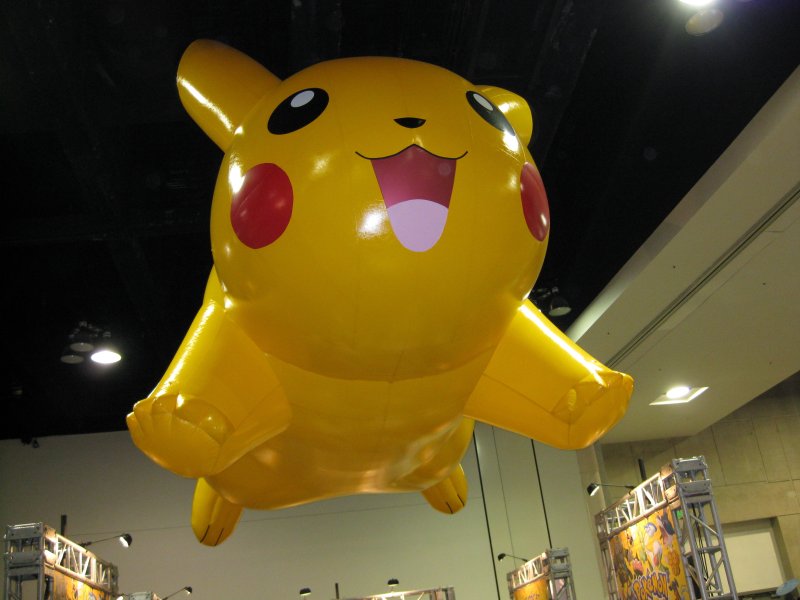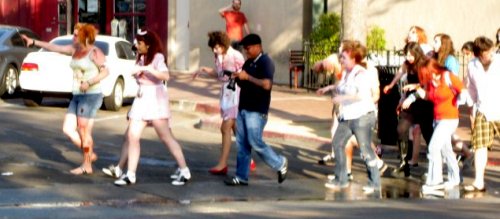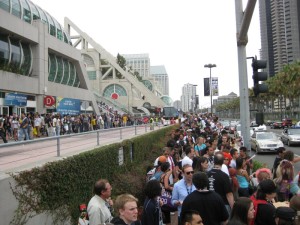A very long story about the adventures of a credit card at Comic-Con. May be funny someday. Continue reading
Tag: Comic Con 2008
Dawn from BTVS: Irrational Character Hate
A post on 20 things I learned at Dragon*Con [edit: no longer available] reminded me of something Katie and I noticed at Comic-Con. During the screening of the musical Buffy the Vampire Slayer episode, “Once More With Feeling,” it seemed like half the audience would boo Dawn, and would shout out things like, “Shut up, Dawn” when she spoke, or “No!” when she sings, “Does anybody even care?”
 Okay, I get that you don’t like the Scrappy… but shouting “Shut up!” when she’s spilling the beans about Willow & Tara’s fight? That sorta implies that you don’t want Tara to find out that Willow has been altering her memories. That’s psychological abuse by any standard. Is it better for Tara to stay in an abusive relationship than for Dawn to be the one to open her eyes?
Okay, I get that you don’t like the Scrappy… but shouting “Shut up!” when she’s spilling the beans about Willow & Tara’s fight? That sorta implies that you don’t want Tara to find out that Willow has been altering her memories. That’s psychological abuse by any standard. Is it better for Tara to stay in an abusive relationship than for Dawn to be the one to open her eyes?
Or how about when she mentions to Sweet that her sister is the Slayer? That sets the rest of the story in motion — in fact, it sets the rest of the season in motion. Not only does it make it possible for them to “beat the bad guy,” but it sets up that Buffy/Spike relationship, and I’d bet 90% of the people booing Dawn just lurve “Spuffy” to death. (Excuse me while I gag.)
It’s hate for the sake of hating the character, even when she does things you like — or things that are necessary.
Personally? I couldn’t stand her through most of 5th season. I’m not sure what turned me around, but it was during the last episode, “The Gift,” that I decided, y’know, she’s okay. Katie, who has a younger sister, found Dawn to be the best characterization of a younger sister on television…and couldn’t hate her for that reason.
Perhaps it was the realism of that sister relationship, seen through Buffy’s eyes, that made so many viewers dislike her. Well, that and the Scrappy effect.
Thoughts for Next Year’s Comic-Con
A couple of things I’d like to do for next year’s Comic-Con International, assuming vacation time and financial situation are compatible:
1. Take the following Monday off. Comic-Con is not relaxing. Even if you don’t go out to parties every night, it’s still exhausting. It wasn’t so bad when we left early on Sunday, but the last two years we’ve stayed all the way to the end of the show. Two-plus hours of driving, plus a stop for dinner, meant we weren’t home until Sunday evening. You’re supposed to be a zombie at the con, not after you get home. It would be much better to take a day to sleep in and recover a bit. (Plus it would allow extra time to do things like sort through photos and post them quickly.)
2. Take the whole week off and make it a vacation. We missed maybe a grand total of 4 hours of daytime programming this year, and still didn’t catch everything we wanted to. (Admittedly, a lot of that involved choosing between simultaneous events.) That doesn’t leave much time to just be in San Diego, except for nighttime. It would be nice to head down the previous weekend and spend a few days as tourists. Maybe hit the Wild Animal Park or something. Then switch hotels on Wednesday and do the con. Certainly our trip to WonderCon earlier this year benefited from taking extra time to do other things.
Being a Nexus – Comic-Con Bursting at the Seams
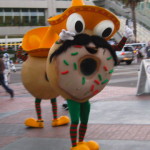 As Comic-Con International strains at the boundaries of the San Diego Convention Center, it’s begun spilling over into the city. Go back 4-5 years, and the most you would see would be the occasional street light banner or bus stop advertisement. Now, there are people handing out flyers as far out as the trolley stops, and walking around the Gaslamp in ridiculous mascot costumes (the sandwiches a few years ago, the donuts this year). There are displays near the trolley stops. There are buses wrapped with full advertisements for movies and TV shows, shuttle vans labeled U.S.S. Enterprise — there was even an ice cream truck parked for several days on 5th street with a Eureka ad on the side (and probably something inside it, but I was always on the other side of the street when I saw it).
As Comic-Con International strains at the boundaries of the San Diego Convention Center, it’s begun spilling over into the city. Go back 4-5 years, and the most you would see would be the occasional street light banner or bus stop advertisement. Now, there are people handing out flyers as far out as the trolley stops, and walking around the Gaslamp in ridiculous mascot costumes (the sandwiches a few years ago, the donuts this year). There are displays near the trolley stops. There are buses wrapped with full advertisements for movies and TV shows, shuttle vans labeled U.S.S. Enterprise — there was even an ice cream truck parked for several days on 5th street with a Eureka ad on the side (and probably something inside it, but I was always on the other side of the street when I saw it).
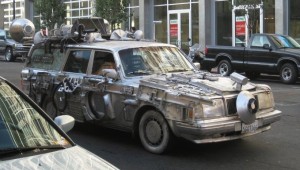
It’s mainly the TV and film studios (except for the flyers), and it ties into something that author Robert J. Sawyer mentioned at his spotlight panel: Convention-goers are nexuses (well, nexi). We’re the people who are so into movies, TV, games, comics, etc. that we’ll put in the effort, time and expense to go to this kind of event, and we’re likely to talk about it. They’re counting on us going back to our offices or dorm rooms, hanging out with friends, blogging, posting on Twitter, or otherwise telling everyone we know about how cool this and that new movie is going to be.
In short: It’s an advertising blitz designed to kick off word-of-mouth hype, aimed at the crowd that’s both most primed to receive it and most likely to spread it.

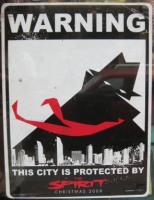 With the massive convention floor and unbelievable crowds, they’re doing everything they can to stand out. So we get the viral marketing, like the ads for TruBlood, the Humans-Only Restrooms signs, the army of people in Quarantine outfits, the Neighborhood Watch–style sign for The Spirit. We get the swag. We get the celebrity appearances. We get displays of terra-cotta warriors to advertise The Mummy and replicas of the Owlship from Watchmen.
With the massive convention floor and unbelievable crowds, they’re doing everything they can to stand out. So we get the viral marketing, like the ads for TruBlood, the Humans-Only Restrooms signs, the army of people in Quarantine outfits, the Neighborhood Watch–style sign for The Spirit. We get the swag. We get the celebrity appearances. We get displays of terra-cotta warriors to advertise The Mummy and replicas of the Owlship from Watchmen.
All that brings in more people, which of course makes the event more attractive to the studios, so they put in more effort, which brings in more people, and they start promoting movies that have nothing to do with comics, sci-fi, fantasy or horror, the genres that used to be the main focus for the con. (I remember thinking that Harold and Kumar Go to White Castle was an odd choice to promote at Comic-Con. This year, the sequel blended right in.)
The con seems to have reached an upper limit in terms of the number of people it can handle at the current venue, which is contracted through 2012. I wonder whether Hollywood will demand bigger crowds — which would probably be best handled by spilling into neighboring hotels — or be satisfied with the numbers it’s got.
Quake and Con
We had an earthquake about an hour ago — 5.4 in Chino Hills, a bit east of Los Angeles. We’re all long-term Californians at work, and there wasn’t any obvious damage (a couple of precariously-balanced objects fell over, but that was it) so discussion was mainly curiosity. Where was it, how big, what type of quake, etc.
But it got me thinking: What if it had happened during Comic-Con?
The quake was felt in San Diego, though there haven’t been any reports of injuries or damage, well, anywhere. Now consider 120,000+ people crammed into an already overcrowded building, many from other parts of the country who have never experienced an earthquake before and aren’t accustomed to them. Some of them would undoubtedly freak out.
Now imagine a hundred or so people in the middle of that Comic-Con crowd panicking and deciding they need to get out, now.
Yeah. I’m thinking stampede. Not a pretty thought.
Comic-Con 2008 Photos are Up!
Here they are: Comic-Con 2008 Photos.
I’ve only got the first page or so labeled for now, but the photos should finish uploading by the time I post this. I’ll fill in the captions and titles over the next few days.
Back from Comic-Con (2008)
Saturday night we met up with my parents after the con for dinner. On the way to the restaurant, Chopahn — very good Afghan food, another one we’d definitely recommend — a mob of people made up as zombies came shambling up the street. We decided to hang back and wait for them to pass.
 Sunday morning we got up early so we could check out of the hotel and move the car. (We left most of our luggage stored at the hotel, but they wanted all the cars out of their valet lot by noon to make room for a new round of guests.) I was amazed that we managed to get a space in a lot literally right across the train tracks from the convention center. Of course, it was around 7:00 AM, and the con didn’t open until 9:30. Neither of us needed to get in immediately today, and standing in line for 2½ hours didn’t seem appealing, so we tried to find something else to do.
Sunday morning we got up early so we could check out of the hotel and move the car. (We left most of our luggage stored at the hotel, but they wanted all the cars out of their valet lot by noon to make room for a new round of guests.) I was amazed that we managed to get a space in a lot literally right across the train tracks from the convention center. Of course, it was around 7:00 AM, and the con didn’t open until 9:30. Neither of us needed to get in immediately today, and standing in line for 2½ hours didn’t seem appealing, so we tried to find something else to do.
We went back to Cafe 222 for breakfast (it seems appropriate that we did it twice), then wandered the Gaslamp district a bit — which is a little creepy at that hour, when very little is open aside from coffee places and restaurants that serve breakfast, and few people are out and about aside from people working at deliveries, taking out trash, etc. and homeless people. Once the William Heath Davis House opened, we went into the museum and took a self-guided tour.
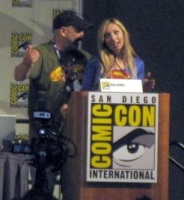 Back to the convention, we both spent the morning combing the floor. I focused on the artists’ area, and ended up getting another sketch, this one of Iris West II by Freddie Williams II. Eventually I made my way to the second DC Nation panel, dashed off a blog post, and discovered that my writeup of the Comic Book Tattoo panel and signing had hit Undented and at least half a dozen other blogs and forums. The 24 hours from 5pm Saturday to 5pm Sunday (midnight to midnight in UTC) had the highest traffic this blog has seen since I installed WP-Stats, something like a year and a half ago.
Back to the convention, we both spent the morning combing the floor. I focused on the artists’ area, and ended up getting another sketch, this one of Iris West II by Freddie Williams II. Eventually I made my way to the second DC Nation panel, dashed off a blog post, and discovered that my writeup of the Comic Book Tattoo panel and signing had hit Undented and at least half a dozen other blogs and forums. The 24 hours from 5pm Saturday to 5pm Sunday (midnight to midnight in UTC) had the highest traffic this blog has seen since I installed WP-Stats, something like a year and a half ago.
Katie hit the Cartoon Voice acting panel, during which room staff moved her purse without telling her. She stood up at the end of the panel and it was gone. We spent the next hour and a half talking to event staff (run by a different organization, so they didn’t actually talk to each other), filing a missing property report, reporting her credit card lost, and looking for the purse itself, until I went back into the room and checked with the tech table — and there it was.
We had just enough time to make it to the sing-along screening of the Buffy the Vampire Slayer musical episode, “Once More With Feeling.” It was different from last year, since it was a much bigger room and the sound was turned up too high to really hear the audience sing, but still a lot of fun.
Afterward, we wrapped up the weekend with ice cream at the Ghirardelli shop. Then we picked up the car and the luggage, and started the long drive home.

